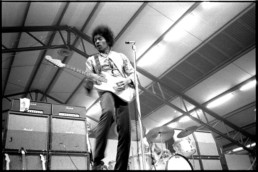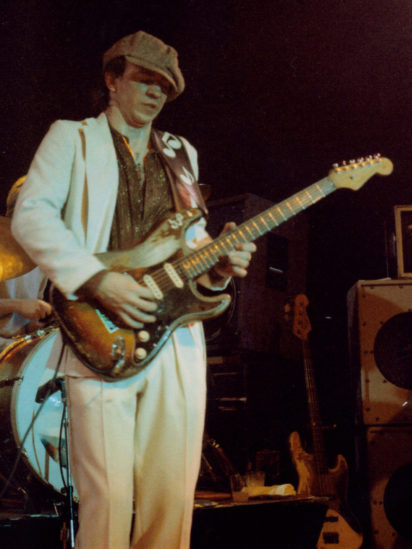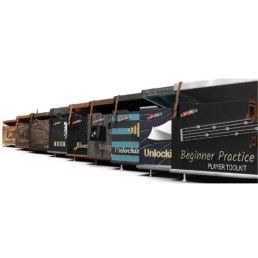4 Best Electric Blues Guitar Players Ever
4 Best Electric Blues Guitar Players Ever
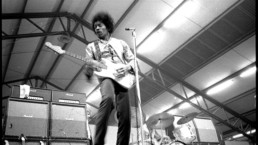
Blues guitar may seem, to some, like a style that was only popular in a past era. But the reality is that whether you are listening to rock, jazz, pop, country, or any modern genre, chances are that its roots lie in the blues – which had some of its early beginnings with blues guitar players!
Blues music originated as spirituals and work songs sung by African slaves in America, but the earliest indication of blues being played on the guitar didn’t come until about 1903. Then, it wasn’t until the late 1930s when blues guitarists started turning to the newly-invented electric guitar. And since then, some of the greatest players have left their legacy in the blues songbook and inspired the players you know and love today. Here are 4 of the best electric blues guitar players ever!
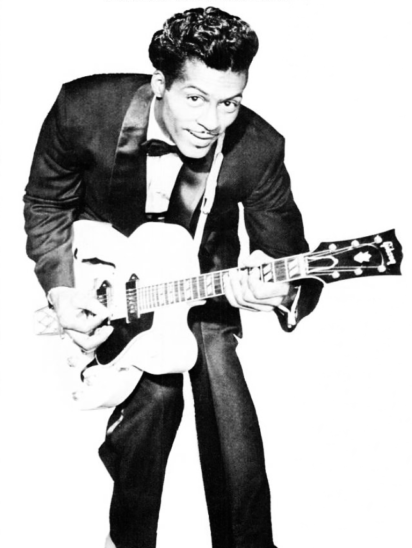
1. Chuck Berry
Dubbed, “The Father of Rock ‘n Roll,” no blues guitarist list is complete without this electric guitar pioneer. Not only was Chuck Berry a masterful guitar player with a style that’s emulated today, he was also known for incredible on-stage showmanship.
Chuck Berry Guitar Lesson with Jeffery Marshall
Get the tab & notation for this Chuck Berry guitar lesson.
In this Chuck Berry guitar lesson, Jeffery Marshall shows you some of Chuck’s most famous guitar licks and tricks. He was known for holding down the rhythm section with 5ths (with added 6ths) through the blues form, and his rhythmic double stop lead guitar lines.
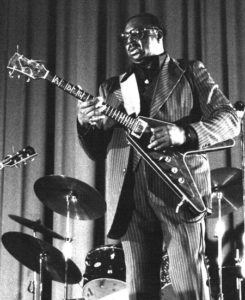
2. Albert King
Albert King, one of the “Kings of Blues,” had a dramatic style of playing that has inspired countless other blues guitarists since the 1950s. Albert was able to achieve large, multi-step string bends due to the fact that he was a left-handed guitarist that played an upside-down, right-handed guitar, and was able to pull strings with better leverage. This is often the most emulated hallmark of Albert’s playing style.
Albert King Guitar Lesson with Jeffery Marshall
Get the tab & notation for this Albert King guitar lesson.
In this lesson, Jeffery Marshall shows you how to approach playing lead guitar like Albert King. Get ready for some big string bends and fierce vibrato!
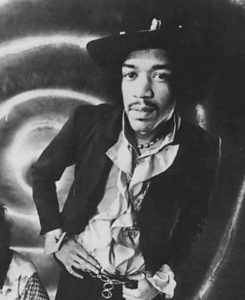
3. Jimi Hendrix
Jimi Hendrix, inspired by the blues greats, himself, is regarded as one of the most prolific instrumentalists in guitar history. A champion of the fuzz and ‘wah’ effects pedal, Jimi pioneered psychedelic rock and was an electric blues savant. Similarly to Albert King, Jimi Hendrix was also a left-handed guitar player who wielded an upside-down, right-handed guitar. The difference, however, was that Jimi restrung his guitar in ascending order as thought it were a standard left-handed six string.
Jimi Hendrix Guitar Lesson with Jeffery Marshall
Get the tab & notation for this Jimi Hendrix guitar lesson.
In this lesson, Jeffery Marshall shows you how Jimi played licks and riffs. This playing style includes using your thumb to reach for notes on the 6th string – don’t worry, we won’t tell your local guitar instructor!
4. Stevie Ray Vaughan
By Bbadventure – Own work, CC BY-SA 4.0
Know for his aggressive right hand strumming technique, Stevie Ray Vaughan brought the blues genre well into the limelight during 1980s. Stevie performed on David Bowie’s Let’s Dance album, released four studio albums, and made many television appearances during his short, 7-year career.
Stevie Ray Vaughan Guitar Lesson with Jeffery Marshall
Get the tab & notation for this Stevie Ray Vaughan guitar lesson.
In this lesson, Jeffery Marshall dives into some of Stevie Ray Vaughan’s unique playing techniques. Get ready to strum the strings like really mean it!
Digging these free guitar lessons? Check out Jeffery Marshall’s full JamPlay guitar course, Legends of Blues Rock: Learn Their Tricks.
Share this
Become a JamPlay member for unlimited access to 7000+ guitar lessons and 120+ artists and instructors. View membership plans ›
Related Posts
Holiday Giveaway: Win This HUGE Bundle of Guitar Gear
Share this
HOLIDAY GIVEAWAY
Win This HUGE Bundle of Guitar Gear!
This giveaway has ended. Thanks to all those who participated!
And congrats to our winner:
Elton V. from North Carolina

Explore the full product listings at Chicago Music Exchange:
- Gretsch G5410T Ltd Edition Electromatic “Tri-Five” Hollow Body electric guitar
- Harmony Series 6 H650 1×12 50W Combo Amp
- Pedaltrain NANO Plus Pedalboard 2 Rails 18×5 w/ Soft Case (+ accessories)
- Walrus Audio National Park Edition Julianna Deluxe Chorus/Vibrato pedal
- Walrus Audio National Park Edition Eras Five-State Distortion pedal
- Walrus Audio National Park Edition SLOTVA Multi-Texture Reverb pedal
A prize package valued at $2,600+ and fit for any genre. It could be yours!
Related Posts
Learn Guitar from the Best: A JamPlay Commercial
Learn Guitar from the Best
A JamPlay Commercial
If you’re gonna learn guitar, why not learn from the best? The best players and the best instructors. The blues solo-ers and the Jam Band rockers. The ones who tap, slide, shred, sweep, and boogie down.
Learn from the Grammy Award winners. And Country Music Hall-of-Famers. From Lady Gaga’s right hand man. And the National Flatpicking Champion. Learn from touring musicians. And lifelong educators.
When you subscribe to JamPlay, these are your guitar guides. What are you waiting for?
Share this
Become a JamPlay member for unlimited access to 7000+ guitar lessons and 120+ artists and instructors. View membership plans ›
Related Posts
Giveaway: Win a Fender Jazzmaster in Pacific Peach and VOX AC30
Share this

This giveaway has ended. Thanks to all those who participated!
And congrats to our winner:
Hannah A. from Upland, CA
This amazing gear bundle features a Fender Player Jazzmaster in Pacific Peach to get your tone in check! With a pre-routed body for a tone circuit and Pure Vintage ‘65 Pickups you’ll be sounding ready to rock paired with this Vox AC30S1 30-Watt 1×12″ Combo Amp. A prize package valued at $1,800+ and fit for any genre.
View the full product listings at Chicago Music Exchange: Fender Player Jazzmaster in Pacific Peach and the Vox AC30S1 30-Watt 1×12″ Combo Amp.
Related Posts
From the Vault: Guitarist Toolkits Streaming
Share this
FROM THE VAULT
Guitarist Toolkits Streaming
A JamPlay 2021 Membership Update
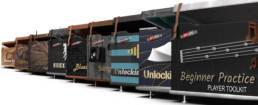
For a few years now, JamPlay Guitarist Toolkits have been released every December as a gift to our annual members. Each year, we create hundreds of hours of incredible learning material in the form of these Toolkits — and every December we retire the previous batch to bring in the new. Well, we decided that it’s time to open the vault and make these available in the Members Area for streaming access!
For PRO Members
We will be making all 9 of the most recent Guitarist Toolkits stream-able in the Members Area for JamPlay PRO members* before January 1st. These Toolkits and their supporting materials (JamTracks, Tabs, Stems, etc) will still also be available for download.
From now until the end of the year, we will announce one Toolkit each week for streaming access. Stay tuned for updates!
Week 1 – Unlocking Rhythm Guitar
Week 2 – Blues Essentials
Week 3 – Rock Essentials
Week 4 – ??

For All Members
Throughout the coming year, we will be adding the FULL ARCHIVE* of Guitarist Toolkits to the Members Area for streaming access. Right now, the Unlocking Rhythm Guitar Toolkit is available for STREAMING in the Members Area and unlocked for all members to get a taste!
*The Unlocking Rhythm Guitarist Toolkit is now available to all JamPlay members for streaming. The Blues Essentials Toolkit (for streaming or download) is available to PRO members as well as members who have purchased access to this toolkit. The full archive of Guitarist Toolkits from previous years (2020 and earlier) will be added in 2022 and will be available to all members for streaming and download.
Related Posts
Comments
Diminished Arpeggios on Guitar with Mark Kroos
Diminished Arpeggios on Guitar
with Mark Kroos
In this lesson from Mark Kroos’ course, Spice Up the Blues, you’ll learn how to use fully diminished arpeggios to solo over the 12-bar blues. Once you’re able to wrap your head around this and get it “under your fingers” it becomes a really simple concept, even though it might seem intimidating at first.
Remember, a fully diminished 7th chord consists of 1, flat 3, flat 5, and double flat 7. That means that all of the notes are a minor 3rd apart. So, since all the notes are the same distance apart, any of those notes could be the root note in a chord shape. Check out the full lesson — unlocked for FREE — to see this in action.
Learn how to play arpeggios on guitar in this lesson with instructor, Mark Kroos and practice variations of diminished arpeggios while playing along to some fun JamTracks!
Spice Up the Blues contains 25 lessons along with a handful of solos sprinkled in to help you master the shapes and skills you’ve been learning. To access the full course, you must become a JamPlay member.
Share this
Related Posts
Comments
Learn to Solo Over the 12-Bar Blues Form [New Course]
Share this
Learn to Solo Over the 12-Bar Blues Form
with Mark Kroos
In this new JamPlay course with Mark Kroos, we are spicing up the way that you solo over the 12-bar blues form. The 12-bar blues makes an appearance in almost every music genre — from Country and Rock, to Funk and obviously, Blues. This course is all about soloing over the 12-bar blues form, how to improve this skill, and getting more comfortable with guitar improvisation.
This is not necessarily a Blues course. We’re going to take ideas from different music genres and implement them into your playing over the 12-bar blues.
Learning to improvise over the 12-bar Blues is the perfect vehicle to work toward soloing over chord changes.
If you’re getting bored with the 12-bar blues form, you might find yourself reverting to minor pentatonic scale shapes. And that’s ok — the minor pentatonic scale can be used over the entire 12-bar blues. But if you’re looking for something new and fun, this course is designed to spice up your playing and spruce up your improvisation, by exploring a wide variety of concepts:
- Switching between major pentatonic and minor pentatonic scales for improvisation, based on our chord changes.
- Dorian mode and Mixolydian mode / Mixolydian Blues scale
- Arpeggios
- Target tones, guide tones, and moving between chord tones
- Using arpeggios to create some really cool lines
- Harmonized lines
- Double stops
- Running sixths up and down the neck of the guitar
- Using harmonized bends to illustrate our chord changes
- Whole tone scale
- Diminished scale
- Diminished arpeggios and how we can use those over the dominant seventh chords in our 12-bar blues
We’ll be borrowing a lot from Jazz in the latter part of this guitar course but we’ll be able to connect it to other music genres like Rock, Funk and Country.
Before you get started…
It will be helpful if you already have some knowledge and skill in the following areas:
- At least one pentatonic scale (major or minor)
- Major scales
- Basic guitar chords
- Dominant seventh chords
- Very basic hammer-on and pull-offs
- How to bend a string
By the end of this course, you’re going to have a lot of options and a lot of tools in your toolbox for working your way around a 12-bar blues solo. It’s also going to give you a very advanced understanding of what you can do when you approach dominant seventh chords — whether that’s in a 12-bar Blues or another piece of music. This course is geared towards intermediate players although advanced guitar players can definitely have fun with it as well!
Spice Up the Blues contains 25 lessons along with a handful of solos sprinkled in to help you master the shapes and skills you’ve been learning. To access the full course, you must become a JamPlay member.
Related Posts
Comments
Jazz Guitar Chords with Marcelo
Share this
Jazz Guitar Chords / Chord Shells
with Marcelo Berestovoy
In this lesson from Marcelo Berestovoy’s JamPlay course, Jazz Chording & Comping (Core Skills), you will explore Jazz guitar chords / chord shells — a quick and easy way to maneuver through jazz chord progressions without actually fleshing out the full chord.
Chord shells are very useful and you definitely want to learn them with the roots on sixth and fifth strings. Marcelo will walk you through these variations while providing tips for finding an implementation for each chord progression that is comfortable for you.
By the way, if you don’t know how to play the 12-bar Blues, stop whatever you’re doing and learn that.
This lesson ends with a few simple exercises to help you practice the chord shells you just learned. Play along with Marcelo’s 12-bar Jazzy Blues progression.
Jazz Chording & Comping: Core Skills contains 24 lessons along with backing tracks that let you play along. To access the full course, you must become a JamPlay member.
Related Posts
Comments
Learn to Play Jazz Rhythm Guitar [New Course]
Share this
Learn to Play Jazz Rhythm Guitar
with Marcelo Berestovoy
Our latest course with Marcelo Berestovoy teaches the core skills needed for a solid foundation in Jazz rhythm guitar and Jazz guitar improvisation. The course material is ideal for Blues players who want to learn some Jazz, for Jazz players who need to work on their rhythm playing, and really for anyone looking to learn Jazz chord progressions. As Marcelo says, “Jazz is definitely the best way to learn about chords on guitar”.
In Jazz, as a guitar player, if you can only play lead and you cannot play rhythm, you don’t really exist. If I have a Jazz gig and I want somebody to only play solos and I don’t need them to play rhythm, I call a trumpet player or a saxophone player. Believe me, nobody is going to call a guitar player to a Jazz gig just to play lead. So…if you don’t know your chords, you can’t have any pudding.
One of the biggest challenges with Jazz rhythm guitar is that you’re not really playing set patterns of chords or exact rhythms. What you’re doing is taking the concepts of the harmony and the rhythm and you’re improvising over that. So in this course, Marcelo will teach you how he approaches Jazz guitar improvisation and rhythm playing and then you’ll get a chance to practice playing over backing tracks to get more comfortable with this skill.
After you’ve taken this course, you are going to walk away with a much better understanding of Jazz guitar chords and an inspired approach to improvisation.
Jazz Chording & Comping: Core Skills contains 24 lessons along with backing tracks that let you play along. To access the full course, you must become a JamPlay member.
Related Posts
Comments
Economy Picking Exercises with Trevor Gordon Hall
Economy Picking Exercises
with Trevor Gordon Hall
In this lesson from Trevor Gordon Hall’s latest JamPlay course, the Melodic Picking Practice Plan, you will explore hammer-ons and pull-offs and you will learn simple economy picking exercises.
Economy picking is different from alternate picking in that with alternate picking you’re always going down-up-down-up-down-up, whereas with economy picking you’ll stay in the same direction when you cross to the next string.
Trevor will cover some of the challenges you’ll face as you start attempting hammer-ons and pull-offs and he’ll explain how you can find ways to engage both the picking hand as well as the fretting hand to overcome these challenges. Next, you learn a simple lick that can be applied in the final economy picking exercises.
With economy picking, what we’re really talking about is an “economy of motion”. Is there any wasted space as you play? Are you leaving the area of the strings every time, having to reset and find your place in order to start again? See if there are any extra movements you might be able to eliminate.
The Melodic Picking Practice Plan contains 25 lessons along with guitar picking exercises and backing tracks that let you play along. To access the full course, you must become a JamPlay member.

